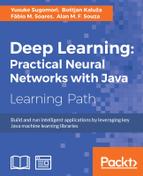From this chapter through to the next chapter, you are going to learn the algorithms of deep learning. We'll follow the fundamental math theories step by step to fully understand each algorithm. Once you acquire the fundamental concepts and theories of deep learning, you can easily apply them to practical applications.
In this chapter, the topics you will learn about are:
In the previous chapter, you learned about the typical algorithm of neural networks and saw that nonlinear classification problems cannot be solved with perceptrons but can be solved by making multi-layer modeled neural networks. In other words, nonlinear problems can be learned and solved by inserting a hidden layer between the input and output layer. There is nothing else to it; but by increasing the number of neurons in a layer, the neural networks can express more patterns as a whole. If we ignore the time cost or an over-fitting problem, theoretically, neural networks can approximate any function.
So, can we think this way? If we increase the number of hidden layers—accumulate hidden layers over and over—can neural networks solve any complicated problem? It's quite natural to come up with this idea. And, as a matter of course, this idea has already been examined. However, as it turns out, this trial didn't work well. Just accumulating layers didn't make neural networks solve the world's problems. On the contrary, some cases have less accuracy when predicting than others with fewer layers.
Why do these cases happen? It's not wrong for neural networks with more layers to have more expression. So, where is the problem? Well, it is caused because of the feature that learning algorithms have in feed-forward networks. As we saw in the previous chapter, the backpropagation algorithm is used to propagate the learning error into the whole network efficiently with the multi-layer neural networks. In this algorithm, an error is reversed in each layer of the neural network and is conveyed to the input layer one by one in order. By backpropagating the error at the output layer to the input layer, the weight of the network is adjusted at each layer in order and the whole weight of a network is optimized.
This is where the problem occurs. If the number of layers of a network is small, an error backpropagating from an output layer can contribute to adjusting the weights of each layer well. However, once the number of layers increases, an error gradually disappears every time it backpropagates layers, and doesn't adjust the weight of the network. At a layer near the input layer, an error is not fed back at all.
The neural networks where the link among layers is dense have an inability to adjust weights. Hence, the weight of the whole of the networks cannot be optimized and, as a matter of course, the learning cannot go well. This serious problem is known as the vanishing gradient problem and has troubled researchers as a huge problem that the neural network had for a long time until deep learning showed up. The neural network algorithm reached a limit at an early stage.
